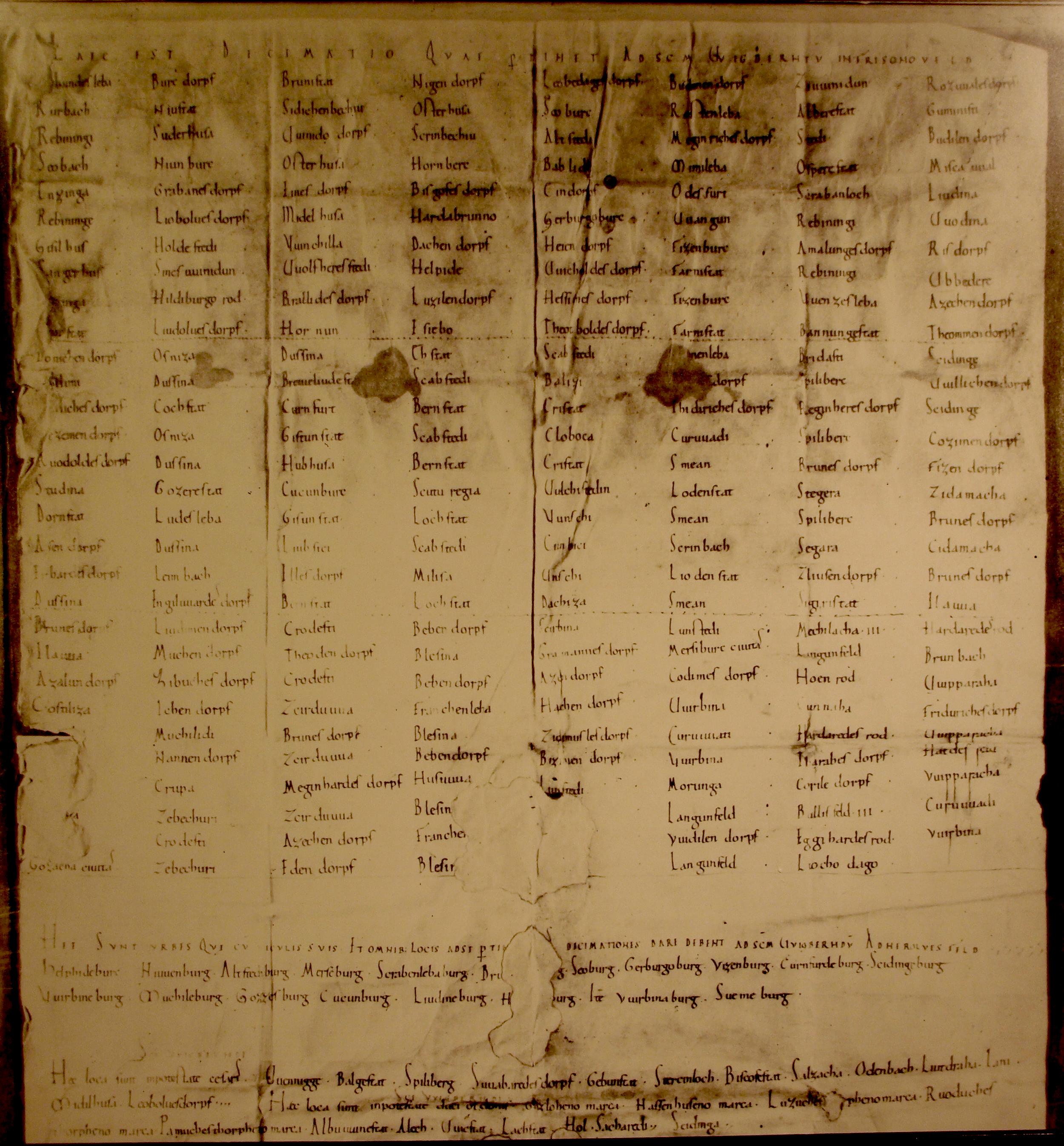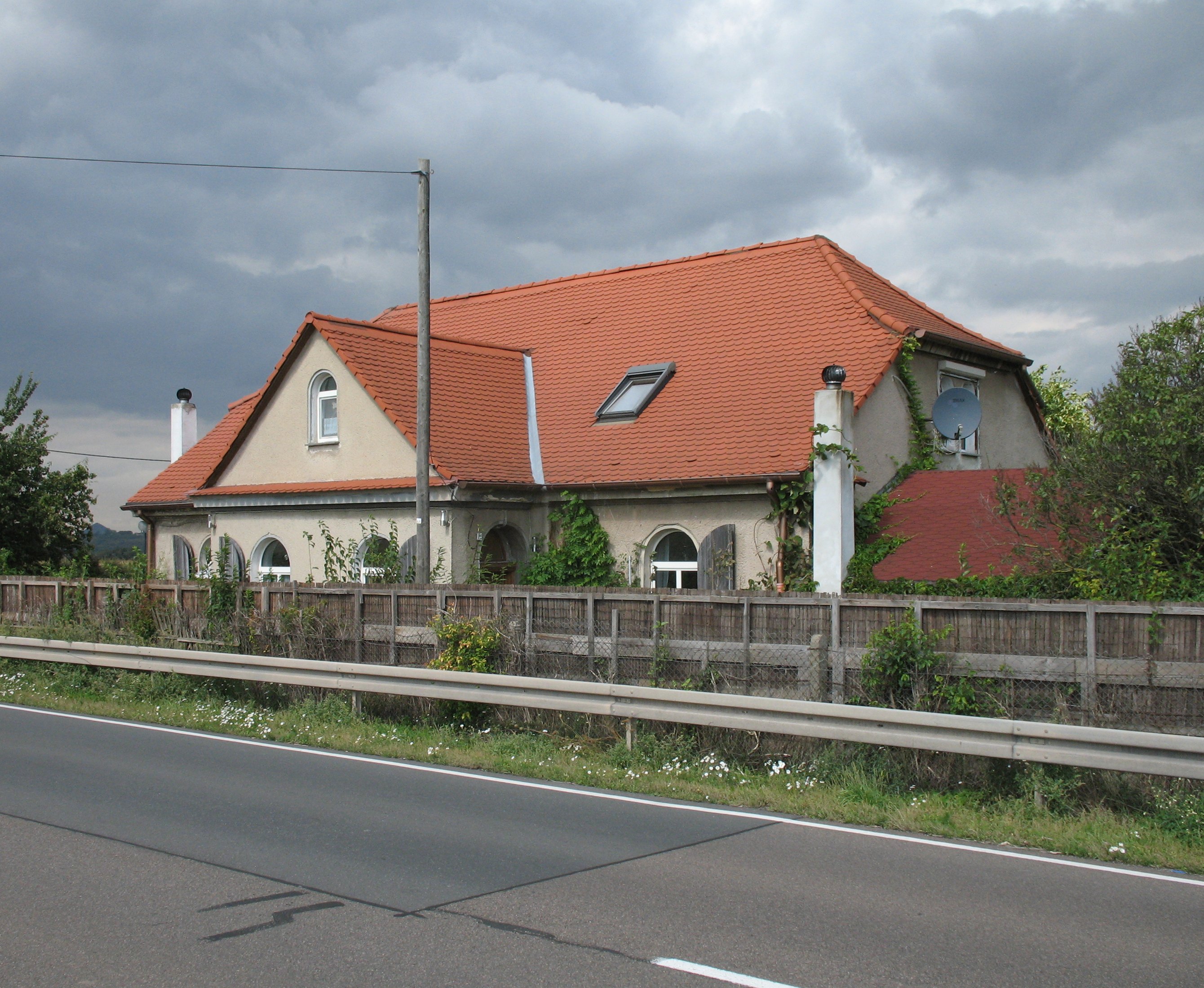|
Hersfeld Tithe Register
The Hersfeld Tithe Register (German: ''Hersfelder Zehntverzeichnis'') is a list of the places and castles in the Friesenfeld Gau (territory) and in Hassegau, from which Hersfeld Abbey received tithes. The original document dates from between 881 and 887 or between 896 and 899, but no longer exists. The list is found in a transcript from the 11th Century, which is now in the Hessischen Staatsarchiv Marburg. The tithe register is divided into four sections. Many placenames are duplicated and triplicated. The first part was apparently compiled between 830 und 860, and lists under 239 numbers a large number of placenames. The second part and subsequent parts were created during the abbacy of Abbott Harderat between 889 and 899 and was bound with the first part and lists 18 names, each of which ends in '-burg' 2. In the third part 13 places are listed and in the fourth 5 markets and 7 places are listed. Many modern placenames in the modern day German states of Thuringia and Saxon ... [...More Info...] [...Related Items...] OR: [Wikipedia] [Google] [Baidu] |
Beyernaumburg
Beyernaumburg is a village and a former municipality in the Mansfeld-Südharz district, Saxony-Anhalt, Germany. Since 1 January 2010, it is part of the town Allstedt, Statistisches Bundesamt of which it forms an ''Ortschaft'' (with the village Othal).Hauptsatzung der Stadt Allstedt January 2020. References Former municipalities in Saxony-Anhalt Allstedt {{MansfeldSüdharz-geo-stub ...[...More Info...] [...Related Items...] OR: [Wikipedia] [Google] [Baidu] |
Mücheln
is a town in the Saalekreis district, Saxony-Anhalt, Germany. Geography Mücheln (Geiseltal) is situated approximately 15 km west of Merseburg and borders Lake Geiseltal to the southwest, west, and northwest. Divisions The town Mücheln consists of Mücheln proper and the following five ''Ortschaften'' or municipal divisions:Hauptsatzung der Stadt Mücheln (Geiseltal) July 2019. *Branderoda *Gröst *Langeneichstädt * *Wünsch These are all formerly independent municipalities: Branderoda, Gröst, Langeneichstädt and Wünsch were absorbed into Mücheln in 2006, Oechlitz in 2010. History First docume ...[...More Info...] [...Related Items...] OR: [Wikipedia] [Google] [Baidu] |
Burgscheidungen
Burgscheidungen is a village and a former municipality in the Burgenlandkreis district, in Saxony-Anhalt, Germany. Since 1 July 2009, it is part of the town Laucha an der Unstrut. Burgscheidungen was the site of the Saxon Hadugato's defeat of the Thuringians under King Irminfrid in 531. This defeat spelled the end of an independent Thuringian kingdom. It is variously attributed to the Franks under King Theuderic I or to their allies, the Saxons under Duke Hathagat. It was one of the founding myths of the Saxons by the ninth century.Karl Hauck, "The Literature of House and Kindred Associated with Medieval Noble Families, Illustrated from Eleventh and Twelfth-century Satires on the Nobility", in Timothy Reuter Timothy Alan Reuter (25 January 1947 – 14 October 2002), grandson of the former mayor of Berlin Ernst Reuter, was a German-British historian who specialized in the study of medieval Germany, particularly the social, military and ecclesiastical ..., ed., ''The Medieval Nob ... [...More Info...] [...Related Items...] OR: [Wikipedia] [Google] [Baidu] |
Lüttchendorf
Lüttchendorf is a village and a former municipality in the Mansfeld-Südharz district, Saxony-Anhalt, Germany. Since 1 January 2010, it is part of the municipality Seegebiet Mansfelder Land. History The first documented mention of Lüttchendorf was as ''Luzilendorpf'' in the Hersfeld Tithe Register The Hersfeld Tithe Register (German: ''Hersfelder Zehntverzeichnis'') is a list of the places and castles in the Friesenfeld Gau (territory) and in Hassegau, from which Hersfeld Abbey received tithes. The original document dates from between 881 ... from the 880's. Former municipalities in Saxony-Anhalt Seegebiet Mansfelder Land {{MansfeldSüdharz-geo-stub ... [...More Info...] [...Related Items...] OR: [Wikipedia] [Google] [Baidu] |
Erdeborn
Erdeborn is a village and a former municipality in the Mansfeld-Südharz district, Saxony-Anhalt, Germany. Since 1 January 2010, it is part of the municipality Seegebiet Mansfelder Land. History The first documented mention of Erdeborn is as ''Hardabrunno'' in the Hersfeld Tithe Register The Hersfeld Tithe Register (German: ''Hersfelder Zehntverzeichnis'') is a list of the places and castles in the Friesenfeld Gau (territory) and in Hassegau, from which Hersfeld Abbey received tithes. The original document dates from between 881 ... of 889. Former municipalities in Saxony-Anhalt Seegebiet Mansfelder Land {{MansfeldSüdharz-geo-stub ... [...More Info...] [...Related Items...] OR: [Wikipedia] [Google] [Baidu] |
Bischofrode
Bischofrode is a village and a former municipality in the Mansfeld-Südharz district, in Saxony-Anhalt, Germany. Since 1 January 2009, it is part of the town Eisleben Eisleben is a town in Saxony-Anhalt, Germany. It is famous as both the hometown of the influential theologian Martin Luther and the place where he died; hence, its official name is Lutherstadt Eisleben. First mentioned in the late 10th century, E .... Former municipalities in Saxony-Anhalt Eisleben {{MansfeldSüdharz-geo-stub ... [...More Info...] [...Related Items...] OR: [Wikipedia] [Google] [Baidu] |
Hornburg, Saxony-Anhalt
Hornburg is a village and a former municipality in the Mansfeld-Südharz district, Saxony-Anhalt, Germany. Since 1 January 2010, it is part of the municipality Seegebiet Mansfelder Land Seegebiet Mansfelder Land is a municipality in the Mansfeld-Südharz district, Saxony-Anhalt, Germany. It was formed on 1 January 2010 by the merger of the former municipalities Amsdorf, Aseleben, Erdeborn, Hornburg, Lüttchendorf, Neehausen, .... Former municipalities in Saxony-Anhalt Seegebiet Mansfelder Land {{MansfeldSüdharz-geo-stub ... [...More Info...] [...Related Items...] OR: [Wikipedia] [Google] [Baidu] |
Wolferstedt
Wolferstedt is a village and a former municipality in the Mansfeld-Südharz district, Saxony-Anhalt, Germany. Since 1 January 2010, it is part of the town Allstedt, Statistisches Bundesamt of which it forms an ''Ortschaft''.Hauptsatzung der Stadt Allstedt January 2020. References Former municipalities in Saxony-Anhalt Allstedt {{MansfeldSüdharz-geo-stub ...[...More Info...] [...Related Items...] OR: [Wikipedia] [Google] [Baidu] |
Winkel (Helme)
Winkel is a village and a former municipality in the Mansfeld-Südharz district, Saxony-Anhalt, Germany. Since 1 September 2010, it is part of the town Allstedt, of which it forms an '' Ortschaft Ortschaft is a term in German speaking countries for a human settlement. In several states of Germany, it is also used for administrative subdivisions of municipalities. These have been defined ...
[...More Info...] [...Related Items...] OR: [Wikipedia] [Google] [Baidu] |
Osterhausen
Osterhausen is a village and a former municipality in the Mansfeld-Südharz district, in Saxony-Anhalt, Germany. Since 1 January 2009, it is part of the town Eisleben Eisleben is a town in Saxony-Anhalt, Germany. It is famous as both the hometown of the influential theologian Martin Luther and the place where he died; hence, its official name is Lutherstadt Eisleben. First mentioned in the late 10th century, E .... Former municipalities in Saxony-Anhalt Eisleben {{MansfeldSüdharz-geo-stub ... [...More Info...] [...Related Items...] OR: [Wikipedia] [Google] [Baidu] |
Lutherstadt Eisleben
Eisleben is a town in Saxony-Anhalt, Germany. It is famous as both the hometown of the influential theologian Martin Luther and the place where he died; hence, its official name is Lutherstadt Eisleben. First mentioned in the late 10th century, Eisleben is divided into old and new towns (Altstadt and Neustadt), the latter of which was created for Eisleben's miners in the 14th century. As of 2020, Eisleben had a population of 22,668. It lies on the Halle–Kassel railway. History Eisleben was first mentioned in 997 as a market called Islebia, and in 1180 as a town. The counts of Mansfeld governed the area until the 18th century. During the Protestant Reformation, Count Hoyer VI of Mansfeld-Vorderort (1477–1540) remained loyal to his Catholic faith, but the family's Mittelort and Hinterort branches sided with Martin Luther, who ended up dying in Eisleben, as discussed below. The German Peasants' War devastated the area, about a century before the Thirty Years War. Count Albert V ... [...More Info...] [...Related Items...] OR: [Wikipedia] [Google] [Baidu] |



%2C_houses_for_the_nuns.jpg)